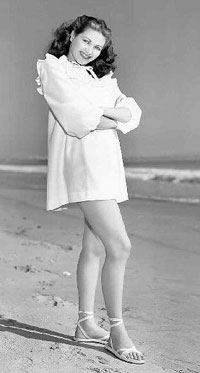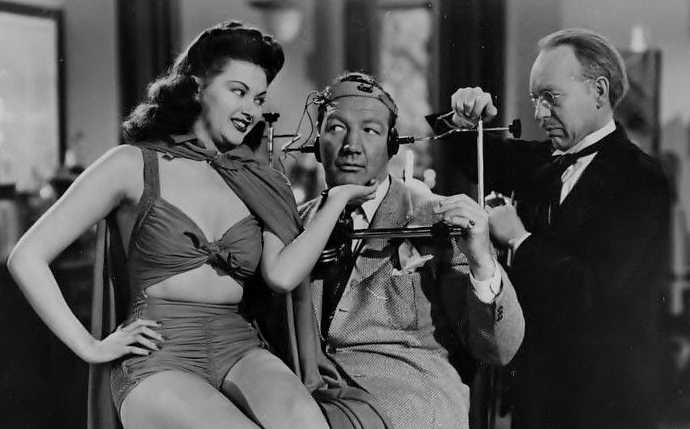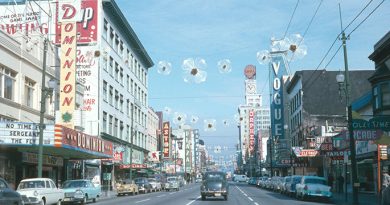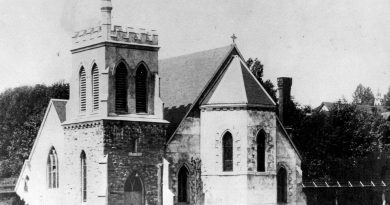Yvonne De Carlo
On September 1, 1922 Mrs. Marie De Carlo Middleton, minutes away from giving birth, was at St. Paul’s Hospital in Vancouver being attended to by two nurses because the doctor hadn’t arrived yet. The nurses said later that, as Mrs. Middleton was being shifted onto the delivery table, she was shouting, “I want a girl. It must be a girl. I want a dancer!”

She got her wish and more. Her daughter, Margaret Yvonne Middleton—later to become Yvonne De Carlo—would become not just a dancer, but a singer, an actress and—in 1945—was named The Most Beautiful Girl in the World. Along the way, she worked briefly as an usherette at the Orpheum Theatre.
In her autobiography, Yvonne, De Carlo doesn’t mention her brief stint in the Orpheum aisles, which seems a shame: Much could have been made of her rise from showing movie-goers to their seats to becoming one of the stars those people came to see.
Peggy was three when her father deserted the family, and her mother became a waitress to help make ends meet. Peggy was a precocious child, with a mother who had ambitions—literally from the beginning, as we’ve seen—to make her daughter a somebody. When she was old enough, her mother arranged acting lessons for her, and enrolled her in June Roper’s British Columbia School of Dance, which at the time was a simple two-room studio on Granville Street. “June rented the Strand Theatre for two days each term,” De Carlo recalled, “as a showcase for her dancers, and to acquaint them with audiences. I took part in a couple of the ‘Stars of Tomorrow’ shows with relative success, but I really came to life in the shows next door at the Orpheum Theatre. June made a deal with the management to stage shows whose theme matched that of the movies that were playing. My debut was in Waikiki Revue in which I did a routine with Ken Mayhew. The audience loved it . . .” (One wonders if the Revue was seen in conjunction with a 1937 Bing Crosby movie, Waikiki Wedding.)
She got a job dancing at the brand new Palomar Supper Club in Vancouver — she says she got the job “a month before it opened.” The Palomar opened May 22, 1937, so she would have been 14 at the time. It was while she was at the Palomar that Peggy decided to change her name. Yvonne De Carlo (De Carlo was her mother’s maiden name) sounded much more exotic. Yvonne and her mother returned to Hollywood in 1940 and the 18-year-old began to get work as a dancer in chorus lines. During the day she and her mother would make the rounds of the studios. It’s said she benefited from June Roper’s connections in Hollywood.
Even so, her first Hollywood work was humbling: acting as a foil in test films for auditioning male actors, someone to say their lines to. Her first real movie came in 1941, a comedy titled The Kink of the Campus. (“Kink” is correct.) Then for the next four years her exotic looks won her small roles as “native girl,” “handmaiden,” “Leona’s companion,” and the like.
The last film in which she had a minor role was Bring on the Girls in which her modest credit was “Hat Check Girl.”
Then, on a September day in 1944 Yvonne opened her apartment door in Hollywood to discover a pile of newspapers left there by University Studio publicists. She read that she had been selected by major film producer Walter Wanger to be the lead in his next movie, Salome Where She Danced. Suddenly, Yvonne De Carlo—described by Wanger as “the most beautiful girl in the world,” was a star. The movie, about an exotic dancer who flees to Arizona after she’s suspected of being a spy, was a hit.
A Vancouver Sun story on September 18, 1944 was headlined Vancouver-Born Beauty Newest Hollywood Find. “Fame was conferred on Miss De Carlo, former King Edward High school student, in typical Hollywood fashion.” The Sun also mentioned she had attended Lord Roberts School before going on to King Ed.
“Her first professional stage appearance here,” the paper reported, “was on the Beacon stage where she appeared in an act with a boxing kangaroo.” That act is described in funny detail in Yvonne. The book has other funny stories, including one concerning the hot young star Tony Curtis. It seems he was making moves on a young Spanish girl, and she rebuffed his advances, saying “No, I should have a duenna.” (A chaperon). Curtis’ Spanish was somewhat sketchy. “Okay, sweetie,” he told her, “We’ll just run down to the drugstore and get one.”
After Salome Yvonne was busy for the next 50 years. She appeared in dozens of theatrical and television movies, co-starring with such movie icons as Clark Gable, Burt Lancaster and Alec Guinness. Thanks to her excellent French, she was the first Hollywood actress to star abroad in a foreign-language film, the 1954 French-made La Castiglione. Her most prominent role was as Sephora, playing opposite Charlton Heston in the 1956 megahit, The Ten Commandments. In 1964 De Carlo became Lily Munster, one of the tongue-in-cheek monstrous Munsters. (One of her immortal lines: “Herman tried to build a ship inside a bottle. We had to break the bottle to get him out.”) She was one of the stars of the Stephen Sondheim 1971 Broadway smash Follies, and made a hit with her singing of I’m Still Here, a song written by Sondheim especially for her.
Yvonne De Carlo visited Vancouver more than once after she left, was one of the stars on hand for the 1987 celebration of the Orpheum’s 60th birthday. She retired in 1995, but there are web sites devoted to her, and many of her more than 75 movies pop up on television to this day.
(Trivia postscript: in the 1952 movie Hurricane Smith, De Carlo’s co-star was John Ireland, also Vancouver-born.)
She died January 10, 2007 in Los Angeles, aged 84.



![Fairview Baptist Church in Vancouver [Image: FairView Baptish Church]](https://vancouverhistory.ca/wp-content/uploads/2021/01/10247407_669782893067748_6617630364129196857_n-390x205.jpg)
